Welcome to our comprehensive Yangon travel guide, where we equip you with all the essential information you need for an unforgettable journey. Discover the climate, top attractions, must-try activities, and much more. By adhering to these invaluable Yangon travel tips, you can ensure an impeccable adventure in this captivating ancient city!
General Information
Yangon, formerly known as Rangoon, is the largest city and the former capital of Myanmar (Burma). Located in the southern part of the country, it serves as a bustling economic and cultural hub. With its rich history, vibrant markets, and stunning architectural landmarks, Yangon offers visitors a captivating glimpse into Myanmar’s unique heritage. From the magnificent Shwedagon Pagoda, one of the world’s most sacred Buddhist sites, to the colonial-era buildings that dot the cityscape, Yangon exudes a charm that is both traditional and cosmopolitan.
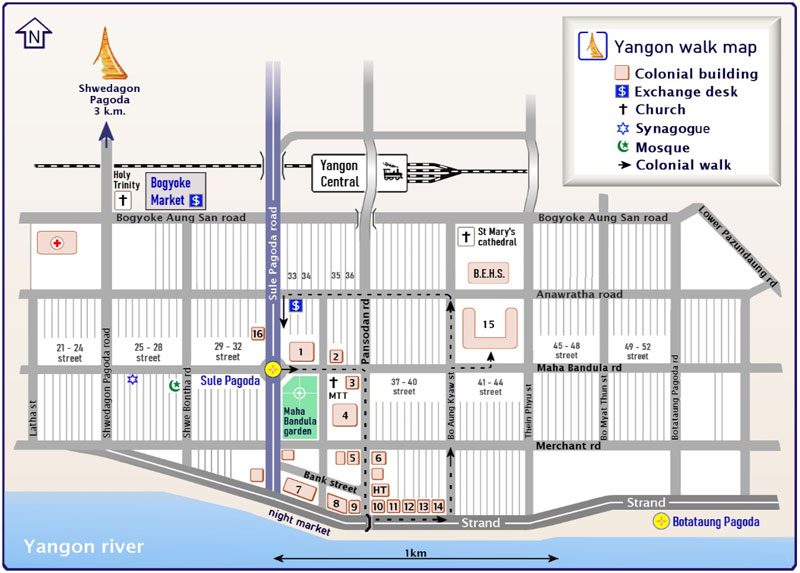
Map of Yangon
Weather and Best Time to Visit Yangon
The weather in Yangon can be described as tropical monsoon, with distinct wet and dry seasons.
- Dry Season (From November to April): During this period, Yangon experiences less rainfall and generally pleasant weather. Temperatures range from 25°C (77°F) to 35°C (95°F), with March and April being the hottest months. It is advisable to carry light and breathable clothing as it can get quite humid.
- Wet Season (From May to October): Yangon receives the majority of its rainfall during this season, with June, July, and August being the wettest months. Showers and thunderstorms are common, often occurring in the afternoon or evening. Temperatures range from 25°C (77°F) to 32°C (90°F) during this period, and high humidity can make the weather feel warmer.
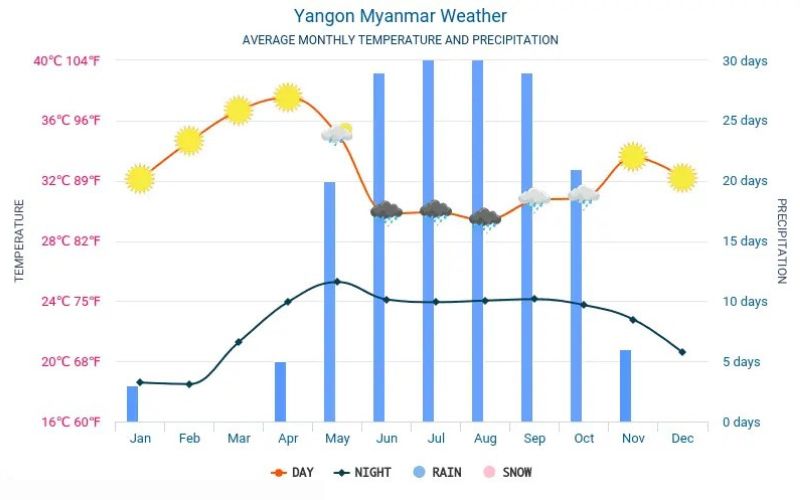
The weather of Yangon
The best time to visit Yangon is during the cool and dry season, from November to February. Visiting Yangon during this period allows you to explore the city comfortably without excessive heat or rain. It’s important to note that while the cool season is generally the best time to visit, it is also the peak tourist season, so popular attractions may be more crowded. Alternatively, if you prefer fewer crowds and are willing to tolerate slightly higher temperatures, the shoulder seasons of October and March can also be good times to visit Yangon.
Getting to Yangon
By plane
Yangon has an international airport called Yangon International Airport (RGN) that is well-connected to major cities around the world. Numerous airlines operate regular flights to Yangon, so you can book a flight directly to the city. Once you arrive at Yangon International Airport, you can take a taxi or arrange for airport transfer services to reach your destination in Yangon.
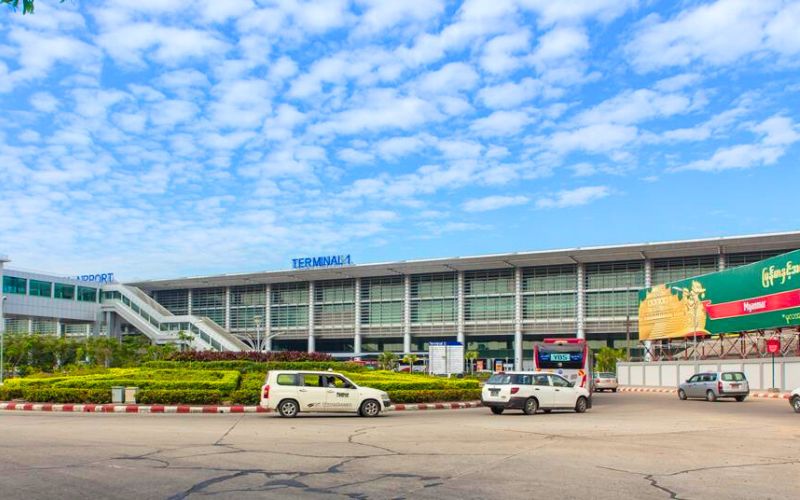
Yangon International Airport (RGN)
By bus
Yangon boasts a comprehensive bus network that efficiently links it to numerous cities across Myanmar. Long-distance buses operate regularly from prominent destinations such as Mandalay, Bagan, and Inle Lake. The duration of these journeys may fluctuate depending on the distance covered and prevailing road conditions.
By train
Myanmar has a train network that connects Yangon with other cities in the country. The train journey may take longer compared to buses, but it offers a unique experience and allows you to enjoy the scenic beauty of Myanmar’s countryside. Trains from Mandalay, Bagan, and other major cities have routes to Yangon.
By boat
From Mandalay, you have the chance to embark on a river journey to Yangon, the former capital of Burma. Indulge in a luxurious ferry adventure aboard the renowned Delta Queen, and set sail on an unforgettable cruise that takes you from Yangon to Pathein. This extraordinary experience promises an unforgettable blend of comfort, serenity, and breathtaking riverine landscapes.
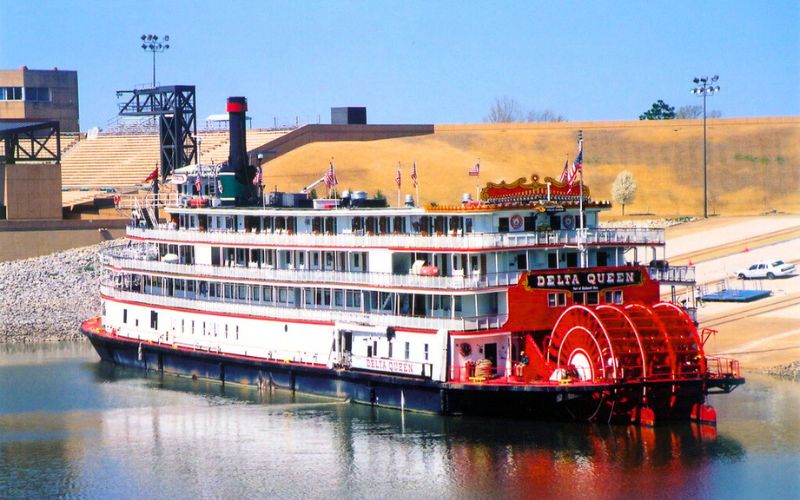
Delta Queen Steamboat
Getting around Yangon
Taxi
Taxis are a popular mode of transportation in Yangon. You can easily find them throughout the city, and they are relatively affordable. It’s advisable to negotiate and agree on the fare with the driver before starting the journey, as most taxis do not use meters. It’s also helpful to have the destination written down in Burmese or show it on a map to ensure clear communication.
Grab
Grab, a ride-hailing service, operates in Yangon. You can download the Grab app on your smartphone and book a ride conveniently. Grab offers both car and motorcycle taxi services, allowing you to choose the most suitable option for your needs. The fare is usually predetermined, providing transparency and convenience.
Bus
Yangon has an extensive public bus network, which is an affordable way to get around the city. Buses can be crowded and routes might be confusing for newcomers, but they offer a glimpse into the local way of life. Fare collection methods can vary, so it’s helpful to have small changes available.
Circular Train
The Yangon Circular Railway offers an economical and picturesque means of discovering the outskirts of the city. Following a circular route around Yangon, this train journey allows passengers to immerse themselves in local culture and relish the scenic vistas. However, you should note that the train may experience delays and become crowded during peak commuting hours.
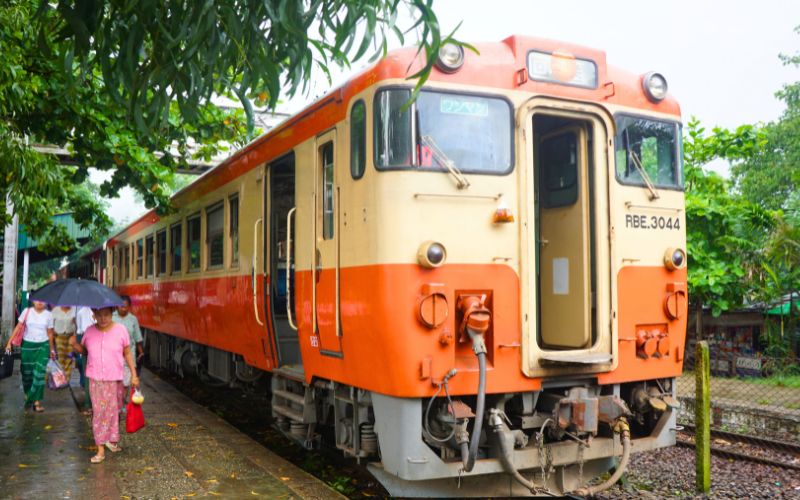
Circular Railway in Yangon
Trishaw
Trishaws, also known as cycle rickshaws or pedicabs, are a popular mode of transportation in Yangon. These three-wheeled vehicles are a common sight on the city streets, providing a unique and traditional way to explore the bustling metropolis. They are typically operated by local drivers who pedal their passengers around the city. Trishaw rides in Yangon are often negotiable, so it’s a good idea to agree on a fare with the driver before starting your journey.
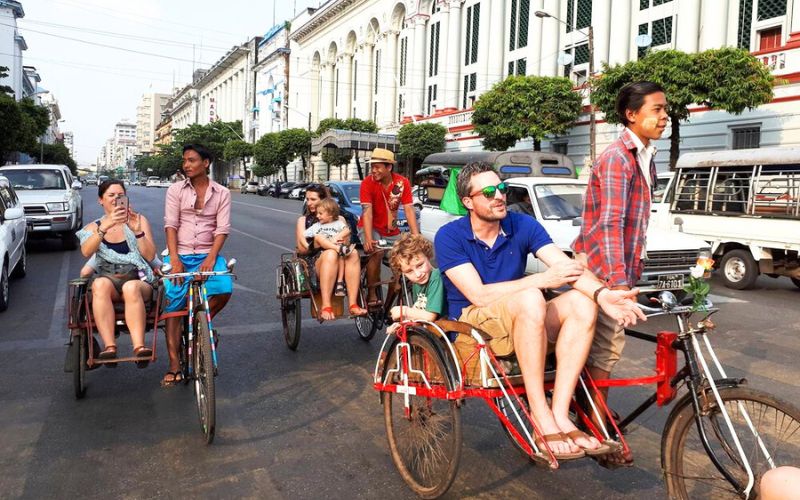
Yangon trishaws
Walking
Yangon’s city center is relatively compact, making it pedestrian-friendly for shorter distances. Walking allows you to explore the streets, markets, and landmarks at your own pace. However, keep in mind that sidewalks can be uneven, and traffic can be heavy, so it’s important to be cautious while walking.
Accommodation in Yangon
Yangon, the largest city in Myanmar (Burma), offers a range of accommodation options at varying price points. When looking for accommodation in Yangon, there are several options available, ranging from budget guesthouses to luxury hotels.
- Downtown Yangon (City Center): This area is a convenient location with easy access to major attractions, markets, and transportation. You can find a variety of accommodation options, including guesthouses, hostels, and hotels, catering to different budgets.
- Bahan Township: Bahan is a residential area popular among tourists due to its proximity to famous landmarks like Shwedagon Pagoda. Here, you can find mid-range hotels to luxury ones, providing comfortable stays and easy access to attractions.
- Chinatown (Latha Township): Chinatown is known for its vibrant atmosphere, street food, and bustling markets. It offers a mix of budget and mid-range hotels and guesthouses.
- Inya Lake Area: This upscale neighborhood surrounds the picturesque Inya Lake and is home to luxury hotels and resorts. It offers a tranquil setting, and spacious accommodations, and often includes amenities such as swimming pools and gardens.
- Airport Area: If you prefer convenience for transit, there are several hotels located near Yangon International Airport. These hotels cater to different budgets and provide easy access to the airport.
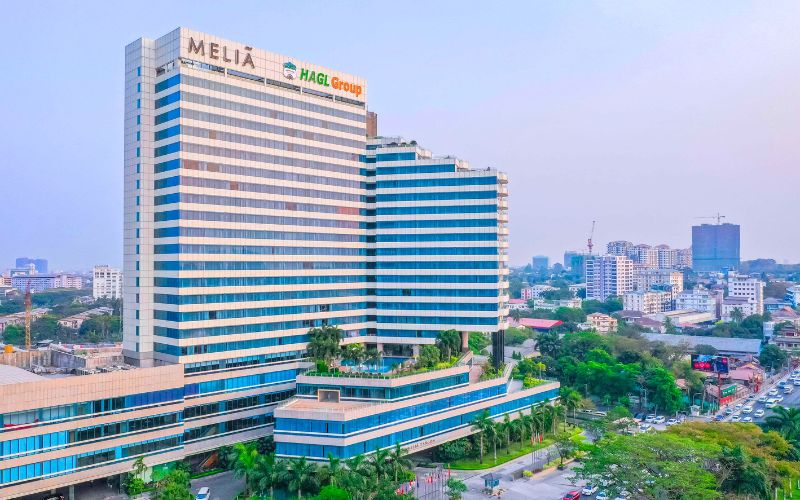
Melia Hotel Yangon
Best Places to Visit in Yangon
Shwedagon Pagoda
The Shwedagon Pagoda holds immense spiritual importance for Buddhists in Myanmar. It is believed to enshrine sacred relics of the Gautama Buddha, including strands of his hair, making it one of the holiest sites in Buddhism. The pagoda stands tall with its golden exterior, reaching a height of 99 meters (325 feet). The main stupa, or zedi, is covered in gold leaf and encrusted with thousands of diamonds, rubies, and other precious gems. The golden spire is visible from various parts of the city.
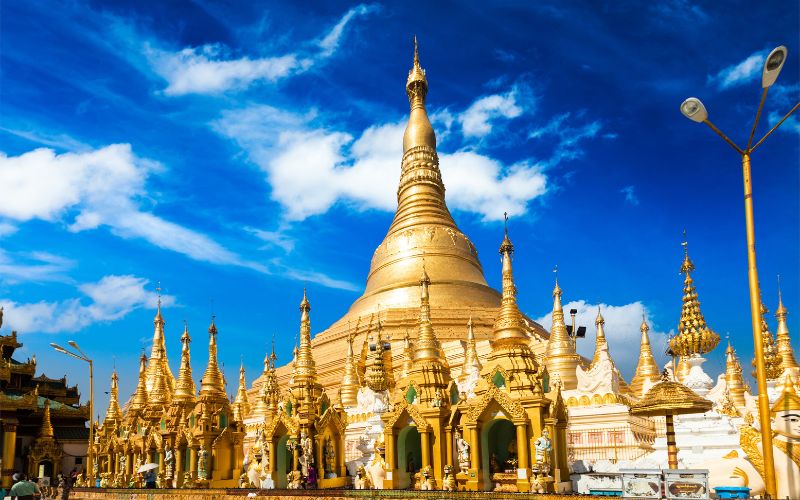
Shwedagon Pagoda
Visitors can participate in various rituals and activities at the Shwedagon Pagoda. Devotees can make offerings, light candles, and pour water over specific Buddha images associated with their birthday of the week. It also hosts several festivals throughout the year, including the grand annual celebration of the Shwedagon Pagoda Festival, which attracts thousands of pilgrims and visitors. During these times, the pagoda is adorned with vibrant decorations, and cultural performances take place.
Sule Pagoda
Situated at the junction of Sule Pagoda Road and Mahabandoola Road, the Sule Pagoda stands in the center of downtown Yangon. The Pagoda holds great historical and cultural significance in Myanmar. It is believed to have been built over 2,000 years ago, making it one of the oldest pagodas in the country. The pagoda has witnessed and survived various historical events and transformations, symbolizing the resilience of Myanmar’s people.
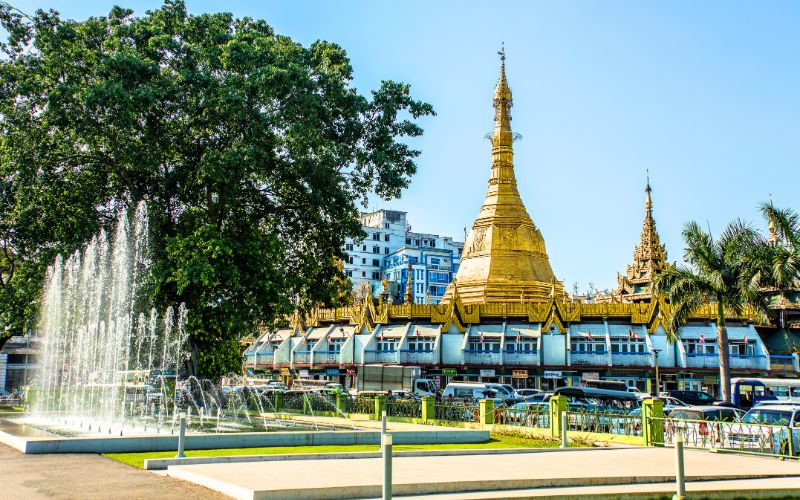
Sule Pagoda
The Sule Pagoda features a unique octagonal shape, rising to a height of approximately 46 meters (150 feet). The structure is adorned with gold leaf and intricate ornamentation. At the pinnacle of the pagoda, a golden spire stands majestically, catching the sunlight and casting a striking presence. The Pagoda also holds spiritual significance for Buddhists in Myanmar. It is considered a place of worship, meditation, and prayer. Devotees often visit the pagoda to make offerings, pay respects to the Buddha, and seek blessings for themselves and their loved ones.
Chaukhtatgyi Pagoda
The Chaukhtatgyi Pagoda, also known as the Chauk Htat Gyi Pagoda, is a prominent Buddhist temple located in Yango. The main attraction of the Chaukhtatgyi Pagoda is its enormous reclining Buddha statue. Measuring approximately 66 meters (217 feet) in length, the statue is one of the largest in Myanmar. It is beautifully adorned with gold leaf and intricate details, including the soles of the feet that display symbols representing the various characteristics of the Buddha.
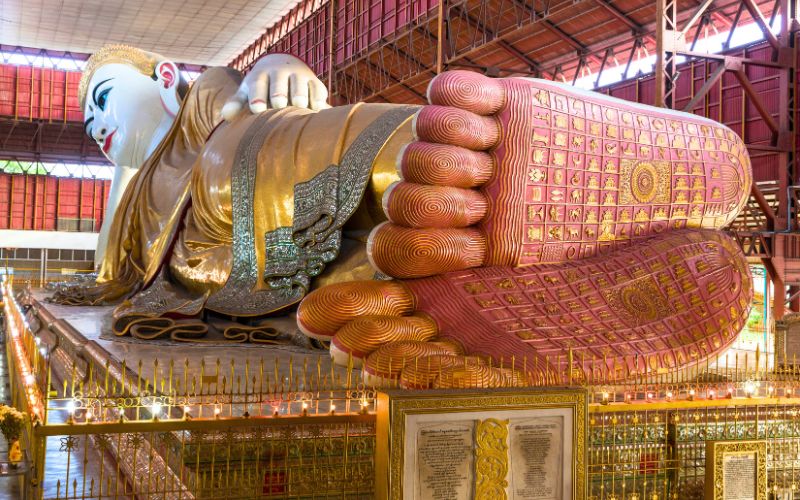
Chaukhtatgyi Pagoda
The Chaukhtatgyi Pagoda showcases remarkable architectural details. The statue’s face is serene, with closed eyes and a peaceful expression. The interior of the statue houses a vast space where devotees can offer prayers and make offerings. Coming here, visitors can observe the local devotees engaging in prayer, and meditation, and making offerings of flowers, incense, and candles to the reclining Buddha.
Kandawgyi Lake & Karaweik Palace
Kandawgyi Lake, also known as the Royal Lake, is a large artificial lake situated in the heart of Yangon. It is renowned for its natural beauty, surrounded by lush greenery and offering stunning views of the Shwedagon Pagoda. The lake features a picturesque promenade that allows visitors to take leisurely walks or enjoy a jog while relishing the tranquil ambiance. There are also seating areas and pavilions where you can sit, relax, and take in the serene atmosphere.
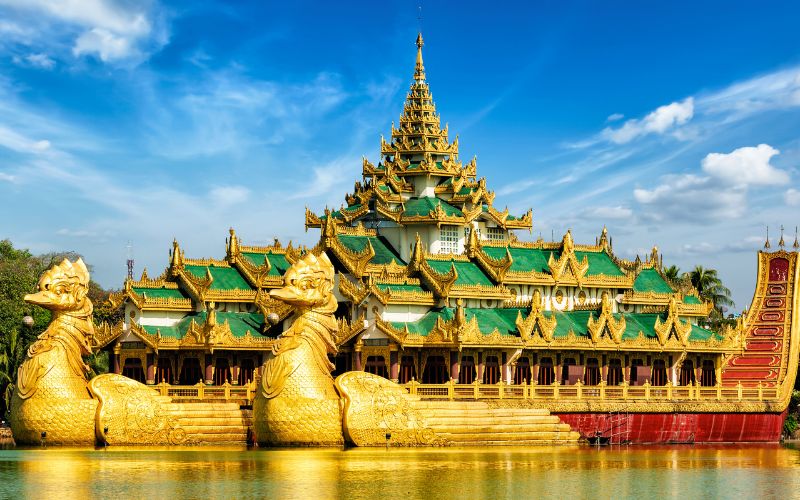
Kandawgyi Lake and Karaweik Palace
The Karaweik Palace, located on the eastern shore of Kandawgyi Lake, is a magnificent structure designed in the style of a traditional Burmese royal barge. It serves as a cultural center, showcasing Myanmar’s rich heritage through performances, music, dance, and traditional arts. The Karaweik Palace’s architecture reflects the intricate details and craftsmanship of Burmese design. The exterior of the palace features elaborate carvings, colorful paintings, and golden accents, creating a visually striking sight.
National Museum of Myanmar
The National Museum of Myanmar is a significant cultural institution that showcases the diverse history, art, and heritage of Myanmar. It houses an extensive collection of historical artifacts, archaeological finds, and cultural treasures from different periods of Myanmar’s history. These include ancient artifacts, sculptures, ceramics, inscriptions, and royal regalia. Besides, the museum provides insights into Royal Myanmar’s rich cultural heritage and traditions. Visitors can explore regal regalia, jeweled ornaments, ceremonial objects, and royal paraphernalia that offer a glimpse into the opulence and grandeur of Myanmar’s past monarchs.
Bogyoke Aung San Market
Bogyoke Aung San Market, formerly known as Scott Market, is a bustling and vibrant market located in the heart of Yango. The market holds historical importance as it was named after General Aung San, a national hero and key figure in Myanmar’s struggle for independence. It has been a central trading hub in Yangon since its establishment in 1926.
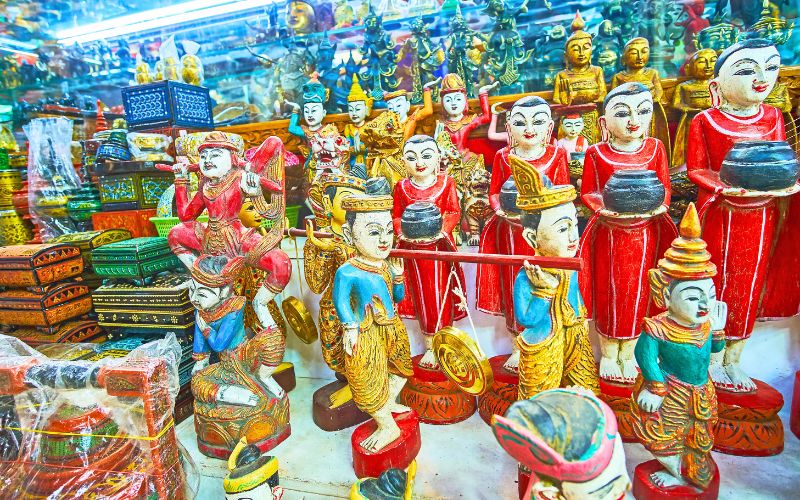
Bogyoke Aung San Market
Bogyoke Aung San Market is a shopaholic’s delight, offering a wide array of goods and souvenirs. It is renowned for its diverse selection of traditional Myanmar handicrafts, including lacquerware, textiles, gemstones, jewelry, traditional clothing (longyi), wood carvings, and artwork. Visitors can also find antiques, artworks, and other unique items representing Myanmar’s cultural heritage.
Botataung Pagoda
The Botataung Pagoda is a significant religious site located in Yangon. It is believed to have been originally built over 2,500 years ago and was reconstructed after being destroyed during World War II. It is named after the thousand military leaders escorting a sacred hair relic of the Buddha brought from India. The pagoda features a unique cylindrical shape with a gilded exterior, shimmering in the sunlight. The golden spire atop the pagoda adds to its majestic appearance. The interior of the pagoda houses a labyrinth-like maze that visitors can explore, featuring golden walkways and chambers.
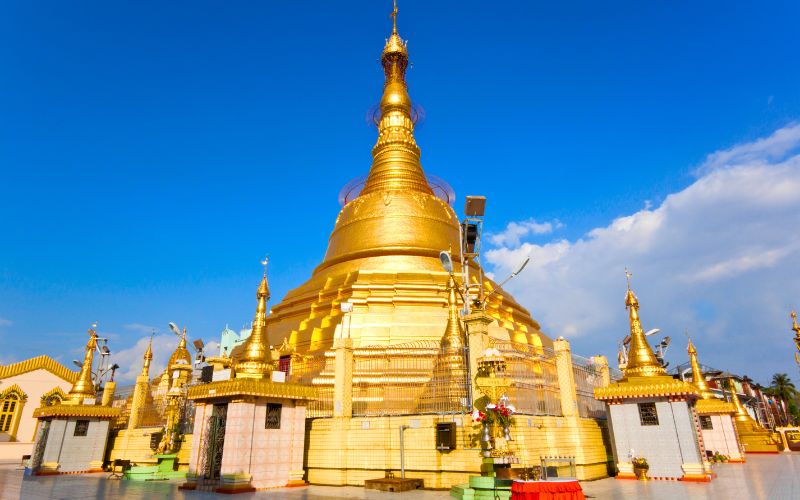
Botataung Pagoda
Mahabandoola Garden
Mahabandoola Garden, also known as Maha Bandula Park, is a charming public park located in the heart of downtown Yangon. The park is named after General Maha Bandula, a national hero who played a significant role in Myanmar’s fight against British colonial rule in the 19th century. The garden serves as a tribute to his memory and the struggle for independence. The green garden is centrally located near prominent landmarks such as City Hall, Sule Pagoda, and the Yangon River. Its strategic position makes it easily accessible and a convenient starting point for exploring the city.
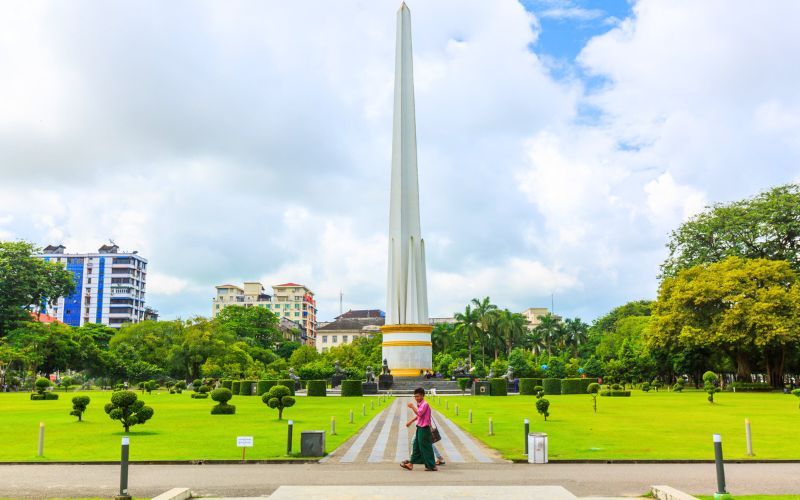
Mahabandoola Garden
Must-try Activities in Yangon
Explore the Shwedagon Pagoda
A visit to Yangon is incomplete without experiencing the majestic Shwedagon Pagoda. Marvel at this iconic Buddhist temple, covered in gold leaf and adorned with precious gems. Take your time to explore the intricate architecture, observe religious rituals, and enjoy the breathtaking views from the pagoda’s elevated platform.
Stroll through Bogyoke Aung San Market
Get lost in the vibrant atmosphere of Bogyoke Aung San Market, formerly known as Scott Market. This bustling market offers a wide range of traditional handicrafts, textiles, gems, jewelry, and souvenirs. Take your time to browse through the stalls, interact with friendly vendors, and find unique treasures to bring back home.
Sample Burmese Cuisine
Yangon is a food lover’s paradise, offering a variety of delectable Burmese dishes. Don’t miss the opportunity to try local specialties such as Mohinga (a traditional fish noodle soup), Tea Leaf Salad, Shan-style noodles, and various curries. Visit local teahouses and street food stalls to savor the flavors of Myanmar’s culinary delights.
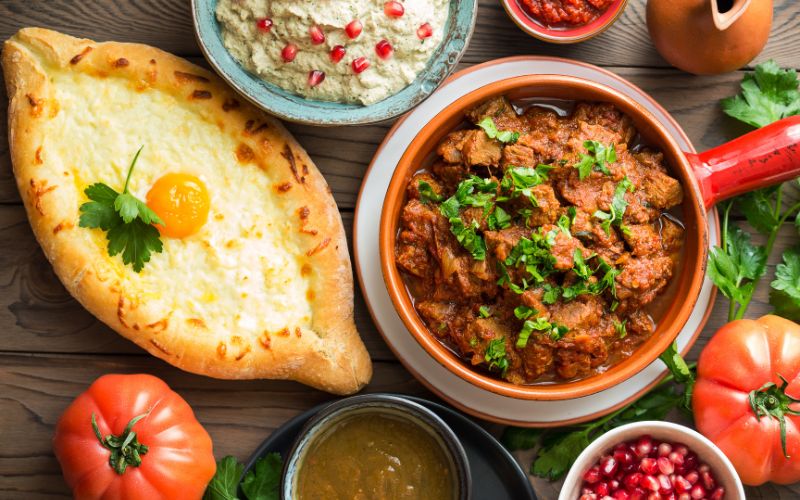
Savor Burmese Cuisine
Take a Circular Train Ride
If you have the chance to get to Yangon, you can immerse yourself in the vibrant local culture by embarking on a memorable adventure aboard the Yangon Circular Railway. This enchanting train journey offers a glimpse into the city’s outskirts, traversing through charming residential neighborhoods, bustling markets, and verdant landscapes. Engage with the warm-hearted locals and witness their daily rituals as you travel alongside them. This authentic and budget-friendly transportation experience grants you a unique perspective on the lives of the people who call Yangon home.
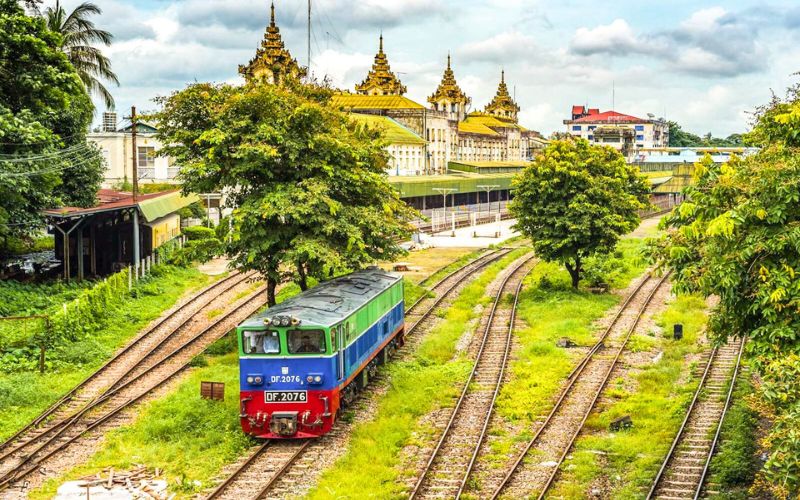
Take a Circular Train Ride
Enjoy the Sunset at Kandawgyi Lake
Make your way to Kandawgyi Lake and be enchanted by the mesmerizing sunset casting its golden glow over the tranquil waters. You can take a leisurely stroll along the picturesque lake promenade, immersing yourself in the serene atmosphere. Don’t forget to seize the opportunity to capture awe-inspiring photos of the magnificent Shwedagon Pagoda, its radiant brilliance mirrored on the serene surface of the lake.
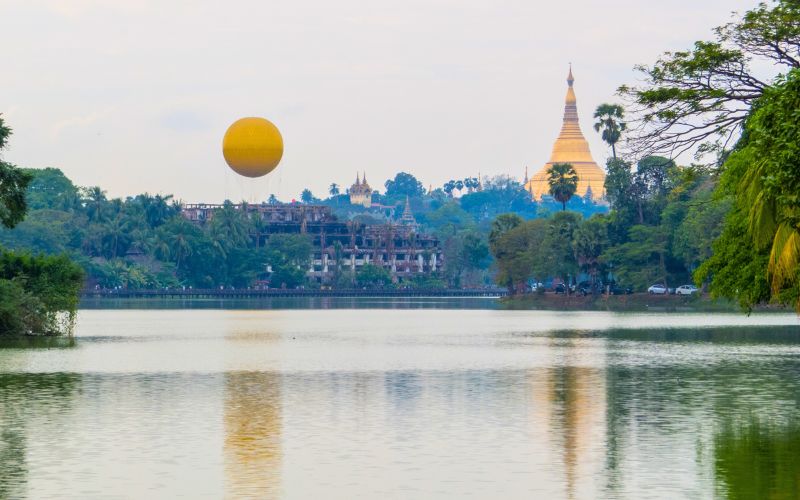
Enjoy the Sunset at Kandawgyi Lake
Attend a Traditional Cultural Show
Experience Myanmar’s cultural heritage by partaking in a mesmerizing traditional dance and music performance. You’ll be attracted by a vibrant array of costumes of performers, their graceful movements, and the enthralling storytelling that animates Myanmar’s age-old traditions. Karaweik Hall and other esteemed cultural centers in Yangon frequently host these spellbinding performances, providing you with a front-row seat to an unforgettable display of artistic excellence and cultural richness.
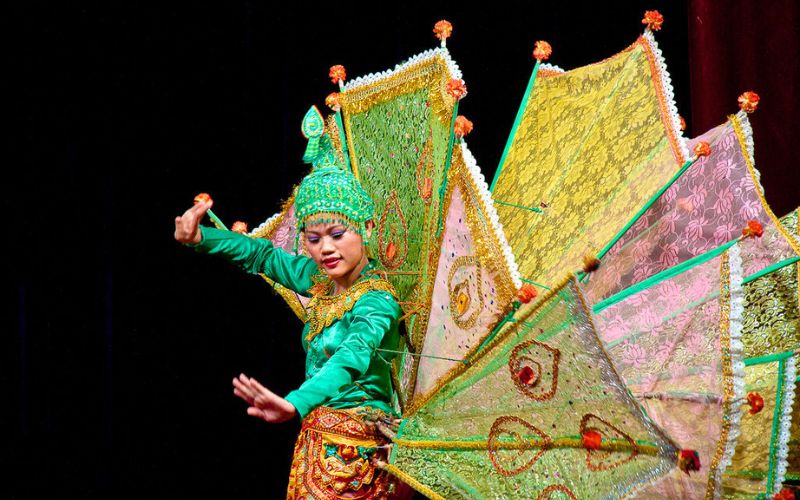
Myanmar Traditional Cultural Show
Must-try Foods in Yangon
Mohinga
Mohinga holds a special place as Myanmar’s national dish, and it’s a must-try for anyone visiting Yangon. This aromatic fish-based noodle soup is commonly savored for breakfast, but you can find it throughout the day. The broth, prepared with a blend of fish, onions, lemongrass, and a medley of spices, emanates a rich and comforting aroma. Served alongside the fragrant broth are rice noodles, crispy fritters that add a delightful crunch, boiled eggs, and a garnish of fresh herbs. The combination of flavors and textures creates a hearty and satisfying dish that showcases the essence of Myanmar’s cuisine.
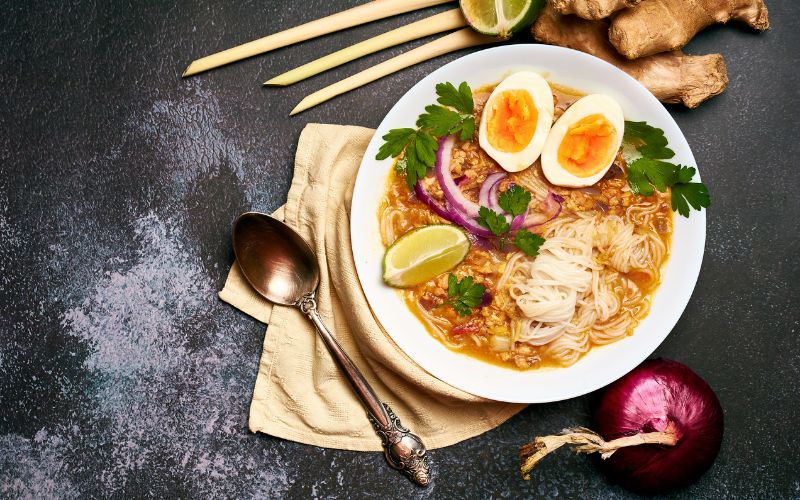
Mohinga
Tea Leaf Salad (Lahpet Thoke)
Indulge in the vibrant and distinctive flavors of Lahpet Thoke, a one-of-a-kind salad that exemplifies the essence of Burmese cuisine. This captivating dish features fermented tea leaves as its star ingredient, combined with chopped tomatoes, roasted peanuts, fried garlic, sesame seeds, and an assortment of other flavorful components. The result is a delightful medley of textures and tastes, boasting a slightly tangy and earthy flavor profile. Lahpet Thoke is a must-try dish that encapsulates the unique culinary traditions of Myanmar, offering a truly immersive experience for your taste buds.
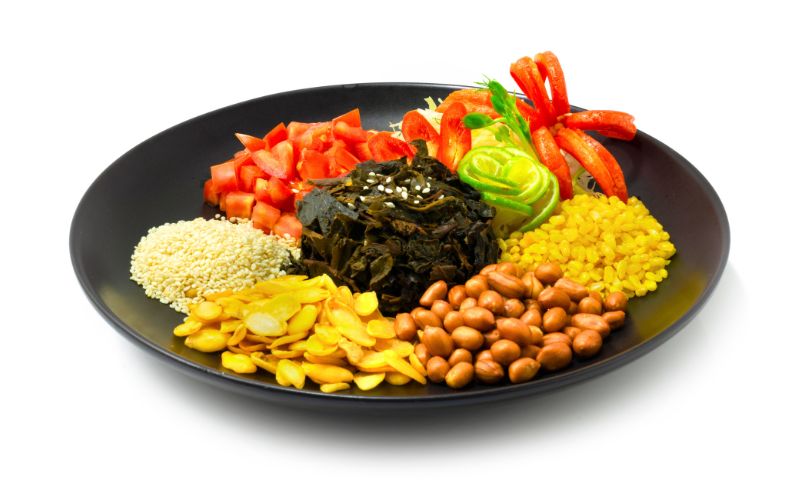
Tea Leaf Salad (Lahpet Thoke)
Shan Noodles
Shan-style noodles have gained immense popularity as a street food delicacy in Myanmar, available in various corners of Yangon. These tantalizing noodles are customarily presented in a fragrant broth, accompanied by succulent cuts of meat (such as chicken or pork), and adorned with an assortment of toppings, including crispy fried onions, fragrant herbs, and zesty lime. The harmonious blend of flavors and textures transforms Shan noodles into an exquisite and gratifying culinary experience.
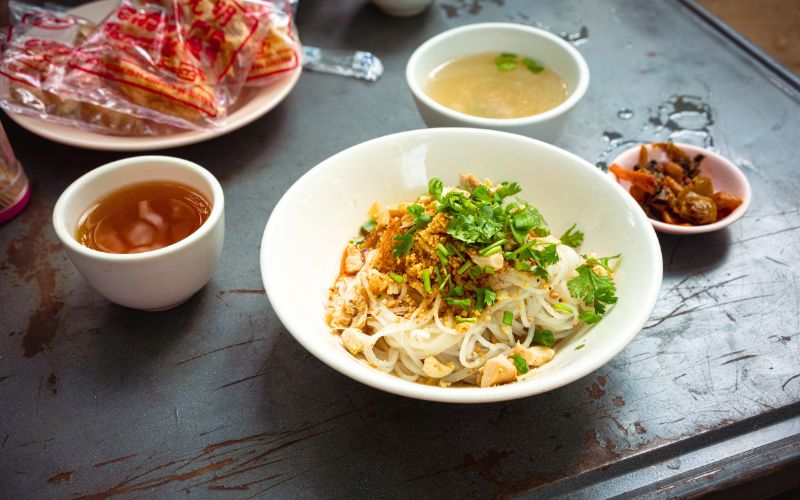
Shan Noodles
Burmese Curry
Myanmar has gained renown for its exquisite curries, renowned for their aromatic richness. From the velvety and gentle notes of chicken curry to the fiery and hearty profiles of beef curry, there exists a curry to appease every taste bud. Rice serves as the customary accompaniment to these curries, while the diverse array of spices employed in their creation imparts a profound and intricate dimension to the dishes, elevating them to unparalleled levels of flavor and complexity.
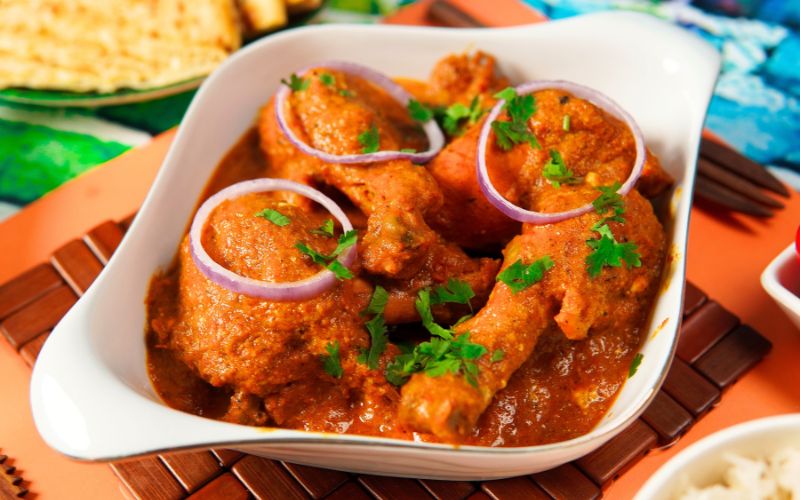
Burmese Curry
Nangyi Thoke
Nangyi Thoke is a beloved dish hailing from Myanmar, renowned for its delightful combination of flavors and textures. This Burmese dish features thick rice noodles that are generously coated in a tangy sauce crafted from chickpea flour. The noodles are then adorned with tender shreds of chicken or pork, crispy bean sprouts that add a refreshing crunch, and a zing of lime for a burst of acidity.
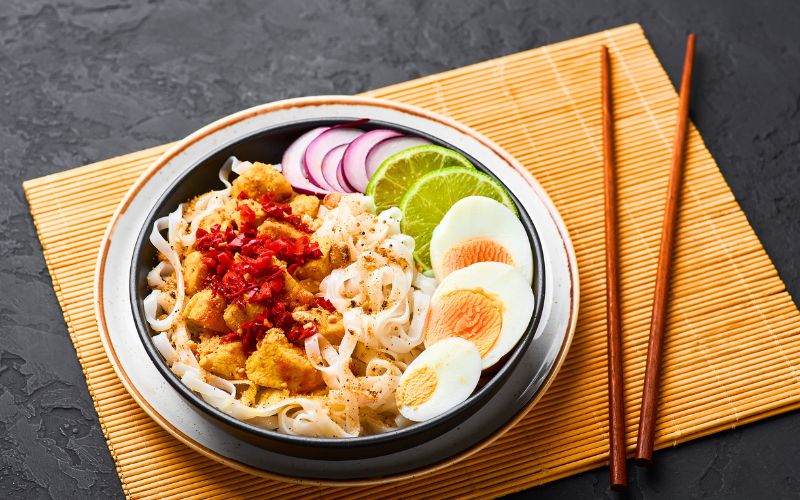
Nangyi Thoke
Mont Lin Ma Yar
Indulging the cravings of those with a penchant for sweets, Mont Lin Ma Yar stands out as an irresistible dessert that one must not miss while in Yangon. These dainty pastries, lovingly deep-fried, are crafted from glutinous rice flour, encasing a delectable filling of either jaggery (palm sugar) or a luscious mung bean paste. With its crisp outer shell and irresistibly tender, saccharine interior, Mont Lin Ma Yar delivers a delightful symphony of textures and flavors, leaving taste buds in a state of blissful satisfaction.
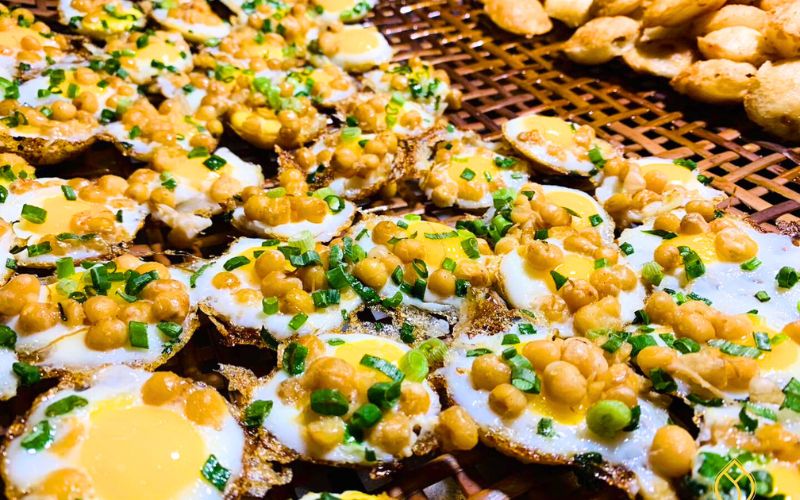
Mont Lin Ma Yar
Yangon is indeed an intriguing destination for travelers exploring Myanmar. Its rich history, vibrant culture, and welcoming locals make it a captivating city to visit. Whether you’re interested in exploring ancient pagodas, immersing yourself in the local way of life, or enjoying the diverse culinary scene, Yangon has something to offer everyone. The city’s unique blend of colonial-era architecture, bustling markets, and serene parks creates a captivating atmosphere that leaves a lasting impression on visitors. So, if you’re planning to explore Myanmar, feel free to contact us for a memorable itinerary.